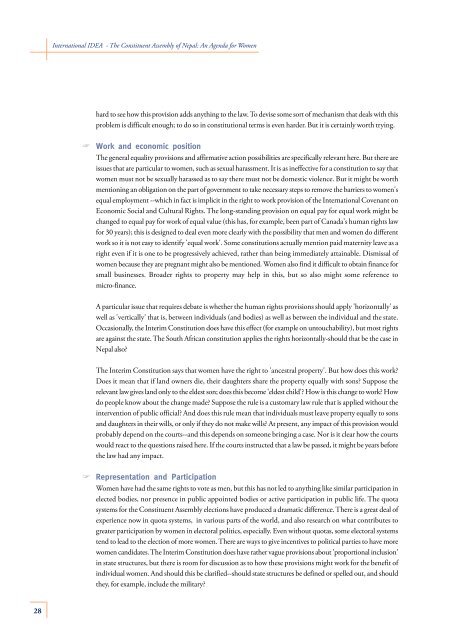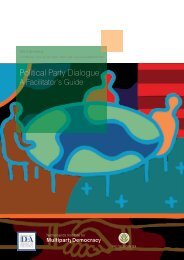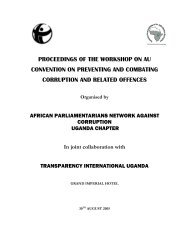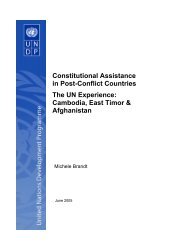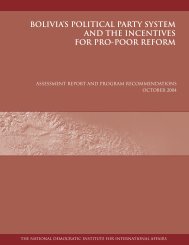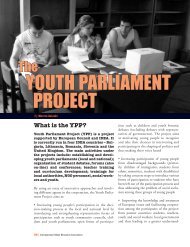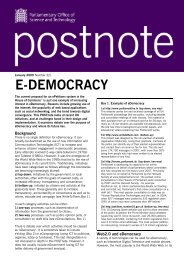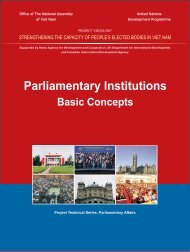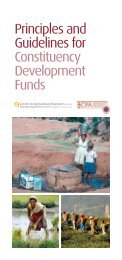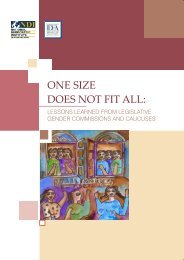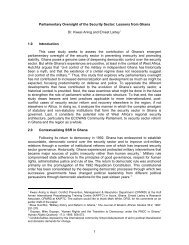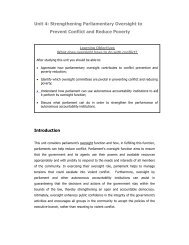The Constituent Assembly of Nepal: An Agenda for Women - CAPWIP
The Constituent Assembly of Nepal: An Agenda for Women - CAPWIP
The Constituent Assembly of Nepal: An Agenda for Women - CAPWIP
- No tags were found...
You also want an ePaper? Increase the reach of your titles
YUMPU automatically turns print PDFs into web optimized ePapers that Google loves.
International IDEA - <strong>The</strong> <strong>Constituent</strong> <strong>Assembly</strong> <strong>of</strong> <strong>Nepal</strong>: <strong>An</strong> <strong>Agenda</strong> <strong>for</strong> <strong>Women</strong>hard to see how this provision adds anything to the law. To devise some sort <strong>of</strong> mechanism that deals with thisproblem is difficult enough; to do so in constitutional terms is even harder. But it is certainly worth trying. Work and economic position<strong>The</strong> general equality provisions and affirmative action possibilities are specifically relevant here. But there areissues that are particular to women, such as sexual harassment. It is as ineffective <strong>for</strong> a constitution to say thatwomen must not be sexually harassed as to say there must not be domestic violence. But it might be worthmentioning an obligation on the part <strong>of</strong> government to take necessary steps to remove the barriers to women'sequal employment --which in fact is implicit in the right to work provision <strong>of</strong> the International Covenant onEconomic Social and Cultural Rights. <strong>The</strong> long-standing provision on equal pay <strong>for</strong> equal work might bechanged to equal pay <strong>for</strong> work <strong>of</strong> equal value (this has, <strong>for</strong> example, been part <strong>of</strong> Canada's human rights law<strong>for</strong> 30 years); this is designed to deal even more clearly with the possibility that men and women do differentwork so it is not easy to identify 'equal work'. Some constitutions actually mention paid maternity leave as aright even if it is one to be progressively achieved, rather than being immediately attainable. Dismissal <strong>of</strong>women because they are pregnant might also be mentioned. <strong>Women</strong> also find it difficult to obtain finance <strong>for</strong>small businesses. Broader rights to property may help in this, but so also might some reference tomicro-finance.A particular issue that requires debate is whether the human rights provisions should apply 'horizontally' aswell as 'vertically' that is, between individuals (and bodies) as well as between the individual and the state.Occasionally, the Interim Constitution does have this effect (<strong>for</strong> example on untouchability), but most rightsare against the state. <strong>The</strong> South African constitution applies the rights horizontally-should that be the case in<strong>Nepal</strong> also?<strong>The</strong> Interim Constitution says that women have the right to 'ancestral property'. But how does this work?Does it mean that if land owners die, their daughters share the property equally with sons? Suppose therelevant law gives land only to the eldest son; does this become 'eldest child'? How is this change to work? Howdo people know about the change made? Suppose the rule is a customary law rule that is applied without theintervention <strong>of</strong> public <strong>of</strong>ficial? <strong>An</strong>d does this rule mean that individuals must leave property equally to sonsand daughters in their wills, or only if they do not make wills? At present, any impact <strong>of</strong> this provision wouldprobably depend on the courts--and this depends on someone bringing a case. Nor is it clear how the courtswould react to the questions raised here. If the courts instructed that a law be passed, it might be years be<strong>for</strong>ethe law had any impact. Representation and Participation<strong>Women</strong> have had the same rights to vote as men, but this has not led to anything like similar participation inelected bodies, nor presence in public appointed bodies or active participation in public life. <strong>The</strong> quotasystems <strong>for</strong> the <strong>Constituent</strong> <strong>Assembly</strong> elections have produced a dramatic difference. <strong>The</strong>re is a great deal <strong>of</strong>experience now in quota systems, in various parts <strong>of</strong> the world, and also research on what contributes togreater participation by women in electoral politics, especially. Even without quotas, some electoral systemstend to lead to the election <strong>of</strong> more women. <strong>The</strong>re are ways to give incentives to political parties to have morewomen candidates. <strong>The</strong> Interim Constitution does have rather vague provisions about 'proportional inclusion'in state structures, but there is room <strong>for</strong> discussion as to how these provisions might work <strong>for</strong> the benefit <strong>of</strong>individual women. <strong>An</strong>d should this be clarified--should state structures be defined or spelled out, and shouldthey, <strong>for</strong> example, include the military?28


